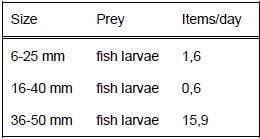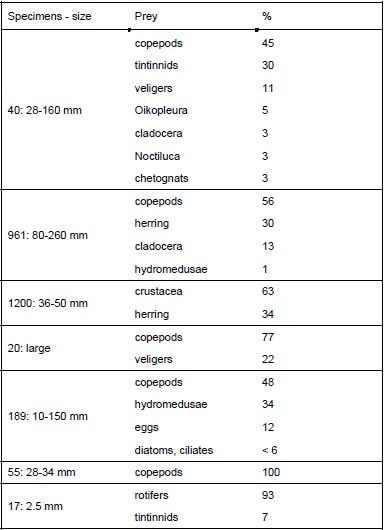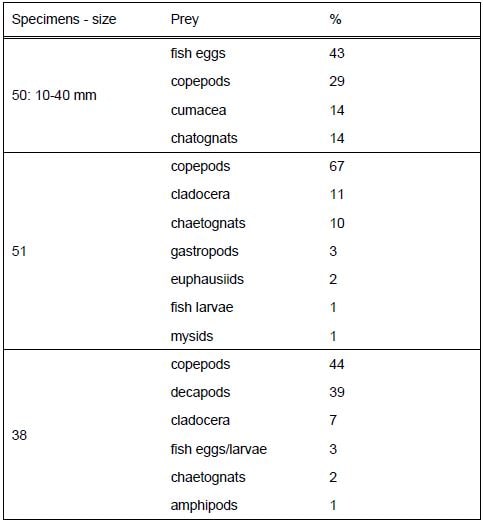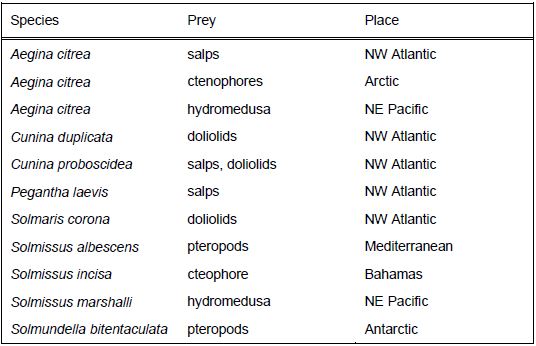1.6 Measures and estimates of predation impacts of gelatinous plankton on fish
The species of gelatinous plankton are in the thousands, and most of them are Hydromedusae (see Bouillon et al., 2004; Bouillon et al., 2006), followed by the Scypozoa and Cubozoa (see Arai, 1997), the Tunicata (see Bone, 1998), and the Ctenophora (see Harbison et al., 1978).
In comparison to the very high diversity of this compartment of plankton, the number of species whose biology and ecology have been investigated is exceedingly small. For most of them we barely know that they exist, and often even their life cycles are unknown.
These predators, furthermore, are very opportunistic since they are equipped with tentacles armed with cnidocysts or colloblasts that can catch almost anything, from unicellular organisms to much larger prey. Some are very specialized in their diets, but most of them feed on anything they can find.
The study of the trophic role of gelatinous plankton, and especially the carnivorous one, is made in two ways. The simplest one consists in collecting animals in the field and inspecting their gut, listing all the food items they contain.
Feeding rates are measured in the laboratory, offering food to the animals and evaluating their clearing rates from a given volume of water and the time of digestion of the offered prey. These studies have been made on few species and at specific places (Tab I and II for Aurelia aurita). If a jellyfish species lives both in the North Sea and in the Mediterranean Sea, as is the case of Pelagia noctiluca (Tab. III), the study of its diet in the North Sea does not necessarily reflect its diet in the Mediterranean Sea, since the available food items might be very different. So, what has been found at one place cannot be automatically extended to all the places where a given species occurs.
Table I. Field predation rates of Aurelia aurita based on stomach contents and digestion rates (after Arai, 1997).

Table II. Stomach contents of field-caught Aurelia aurita of various sizes and at different sites, as percentage of prey numbers (after Arai, 1997).

Table III. Stomach contents of field-caught specimens of Pelagia noctiluca of various sizes and at different sites, as percentage of prey numbers (after Arai, 1997).

Some species, as the scyphozoan Drymonema dalmatinum, apparently feed only on other jellyfish, since Larson (1987) inspected 13 specimens and found only medusae in their guts. The same seems true also for Narcomedusae in general (Tab. IV).
Table IV. Gut content of Narcomedusae collected in situ (after Larson et al., 1989).

These gelatinous plankton eaters might be a natural mitigation of the impact of the predation pressures of their prey on crustacean and fish plankton, as largely demonstrated for the main predator of Mnemiopsis leyidi in the Black Sea: the ctenophore Beroe ovata (see, for instance, Shiganova et al., 2004).
Purcell and Nemazie (1992) showed that the only prey of the hydromedusa Nemopsis bachei are copepodites of Acartia clausi, even though they stated that the observed predation could not affect significantly the population size of the copepods. Also Pelagia noctiluca, the main former of jellyfish blooms in the Mediterranean Sea, feeds mostly on copepods, even though Sabates et al. (2010) report that 12 percent of its diet is made of fish larvae.
Arai and Purcell (2001) reviewed the available information on the impact of predation of gelatinous predators on fish (Tab. V).
Table V. Numbers of fish eggs and larvae eaten per day by single specimens of various gelatinous predators (after Arai and Purcell, 2001).
Species Prey per day
Physalia physalis 120
Rhizophysa eysehardti 9
Aequorea victoria 91±147
Nemopsis bachei 4±3
Aurelia aurita 1,6
Chrysaora quinquecirrha 343±419
Mnemiopsis leidyi 42±33
Gelatinous herbivorous filter feeders (namely Thaliacea and Appendicularia) are extremely efficient in removing phytoplankton from the water column and, when present in huge swarms, they can impair the potential for feeding by crustaceans (see Bone, 1998 for a monograph). Harbison and McAlister (1979), with laboratory experiments, showed that Thaliaceans of various species do perform clearing rates of 100 percent.